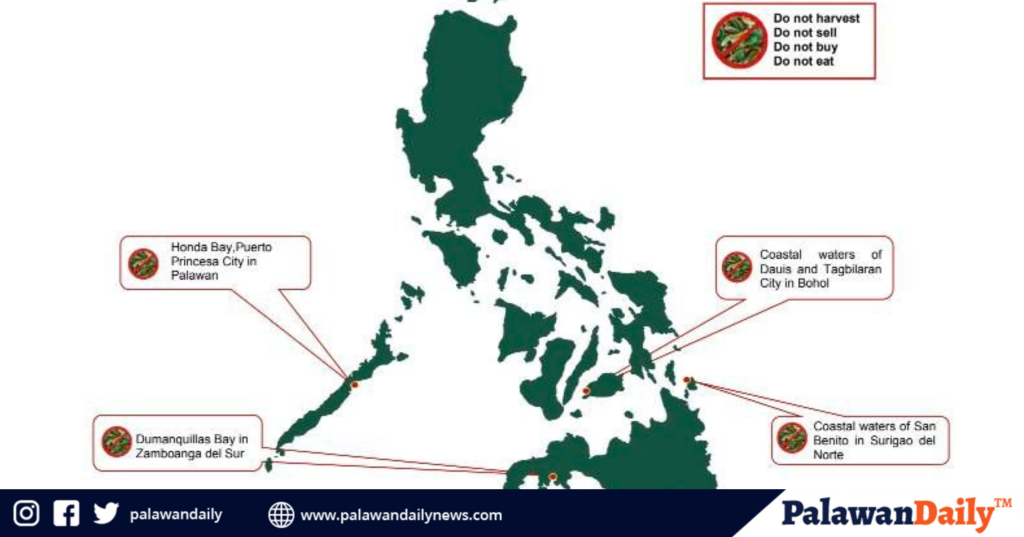The Bureau of Fisheries and Aquatic Resources (BFAR) Central Office has detected presence of red tide toxins in Honda Bay in Puerto Princesa and advised the public to refrain from gathering, selling and eating shellfishes since the area is positive for the deadly Paralytic Shellfish Poison (PSP).
Five years ago, in July 2019, when red tide toxins were detected in Puerto Princesa, BFAR sounded the alert in a Shellfish Bulletin. The warnings appeared with dreaded regularity for nearly five months, untill the ban was lifted in October 2019, which many fisherfolks and shellfish gleaners considered as one of the longest period when shellfish ban was imposed. BFAR and local authorities also imposed shellfish bans during several months of 2020 and 2021 in Puerto Princesa City.
In Memorandum Order No. 235 issued by the Office of the City Mayor of Puerto Princesa on July 1, 2024, City Administrator Atty. Arnel M. Pedrosa directed to cause the proper dissemination of information. He also instructed the City Harmful Algal Bloom (HAB) Task Force composed of the different offices of city government to convene immediately to ensure shellfish ban of all types of shellfishes or alamang gathered from Honda Bay, “to ensure public safety and to avoid PSP in view of the occurrence of HAB in Honda Bay.”
The City HAB Task Force includes the Office of the City Agriculturist and other offices of information, tourism, disaster risk reduction and management, barangay community affairs, environment and natural resources, health, fish port and public market, and KAAC program manager.
Senior Aquaculturist Joven Delgado of the Office of the City Agriculturist explained that Honda Bay is from the coast of Langogan to San Miguel.
He said that their office has been monitoring in areas where there are shellfish vendors, including that in public markets, and in talipapa in Tagbato, Tagburos, San Jose, San Manuel, among others. They also seek the help of the different offices such as the Office of the City Fish Port, and the Public Market Office, City Environment and Natural Resources Office (City ENRO) through its Environmental Law Enforcement Division (ELED) so that shellfish ban is strictly enforced.
Since there are other areas within the city that are not affected by the shellfish ban, shellfish vendors including those ambulant and transient, are required to present certificate of origin to ascertain the source of their shellfish products.
Delgado informed that he coordinated with the different municipalities in Palawan, specifically from their respective Municipal Agriculture Offices/ Officers (MAOs) in connection with their issuance of certificate of origin, which shall reflect the BFARMC signatories from the areas where these shellfishes are collected. The name, signature and contact number of the signatory from the MAO, volume/ quantity of the shellfishes, and the species. Within Puerto Princesa City, the BFARMC certification shall be duly signed by the Punong Barangay where the shellfishes are collected.
Eating toxic shellfish can bring on severe stomach pain, diarrhea, vomiting and even death, within hours. Shell fish species when there are presence of red tide toxins cause poisoning in coastal areas, due to the deadly toxins they imbibe from HABs. The blooms are made up of millions of microscopic two-tailed algae called dinoflagellates, which when present in dense quantities, appear as clouds of red in the sea. The phenomenon is called “red tide’. The reddish colors come from some dinoflagellates that have photosynthetic pigments ranging from brown to red.
The appearance of HABs is linked to several factors. The main one is the availability of nutrients like iron, nitrogen and phosphorous from sewage, agricultural wastes and other waste that are pumped into the sea from various sources.
“Dahil sa maatagal na tagtuyo at naiipon ang mga organic matter sa itaas. Nung umulan na ay na wash out ang mataas na nutrients na ito, papunta sa dagat,” Delgado explained.
